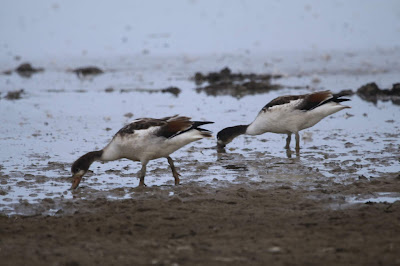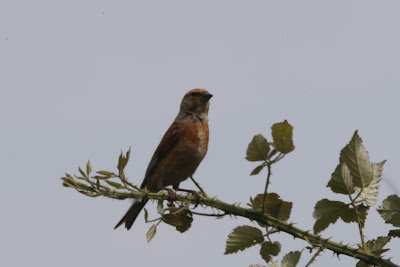When I stand on top of Whin Hill and look down on Island Mere and the surrounding extensive reedbeds, the wet grassland beyond, my eyes gradually reaching a horizon of woodland at Sizewell Belts, I can't but help feeling optimistic. All this before me is for nature, this is right, this is what our countryside should be about, about wild things, not just the industrialised production of food.
Whin Hill is an area of high ground that overlooks the marshes of Minsmere, where BBC Springwatch was based for a couple of years. Its an area of grassland full of GREEN WOODPECKERS and rabbits. Its also on the route back to the car park from Island Mere hide.
I was over at Minsmere on this late August day, primarily to look for southbound Autumn migrants. There were a few birds about, but on the whole things were fairly quiet, by this I mean quiet for Minsmere, which is still better than most reserves.
The remains of the abbey sits atop a small hill, an island above the marshes
But first, before I start the bird report, I must talk about the scones. The café at Minsmere serves great scones, big door stop scones, homemade scones, they make the perfect meal to start a trip out on the reserve.And I didn't have to go far. In the pond area - the old carp park - there was a PIED FLYCATCHER, first in some bushes, then it flew to the top of a tall tree, where it would fly out and catch insects on the wing - the typical behaviour of a flycatcher. There had been an influx all along the coast this week, but with only a few at each site it still took some effort to find them. There was a small twitch of five or so people stopping to admire this bird of northern oak woods.
RINGED PLOVER
The end of August is usually the best time for WADER migration, when it usually reaches its peak. However this year the peak has been a bit earlier, and what I witnessed was a waning of the Autumn period. There was still a decent selection about, I don't usually list things but I will do so here. The Scrape, where the WADERS foraged is split into East, West and South sections, each slightly different to the other.On East Scrape:
23 AVOCETS 2 COMMON SANDS 3 LITTLE RINGED PLOVERS 1 DUNLIN 1 RUFF
I GREEN SAND
On South Scrape:
10 RINGED PLOVER 8 DUNLIN 2 SPOTTED REDSHANK 2 CURLEW SANDPIPER
On West Scrape:
3 SPOTTED REDSHANK 6 SNIPE I GREEN SAND
Aside from the waders the Scrape was very quiet with only a few DUCKS about. On the pool behind South Hide there was a late brood of TUFTED DUCK.
CORMARANT through the reeds
Family parties of BEARDED TITS were found in the reed fringes of East Scrape and in the Konik Fields, and from what I can see they have had a good breeding season.
A very late CUCKOO was on East Scrape, and because it looks like a bird of prey caused consternation amongst the birds on the scrape, putting some into the air. This is my latest ever record of this bird species. As the adults don't take part in raising their chicks they leave quite early. This was a brown juvenile, maybe locally born.
This is only a snapshot of what was about, as there were lots and lots of common birds about I really couldn't note every single one of them. For example there were lots of PIED WAGTAILS about, but you can find loads of them around any supermarket car park as well. But they are still nice, happy birds, wagging their tails with what I assume is joy.
The jetty, the only time you can tell if its high tide at Minsmere is when the jetty is covered in water
So passes another summer's day down at Minsmere, with the usual suspects about, nothing out of the ordinary. With so much about, not just here but all along the coast one visit just seems to barely scratch the surface. Oh to give up work and live my life in the countryside. But I have to get back to civilisation, to TV, laptops, the internet and blogs about bird watching. Its a hard life.






































